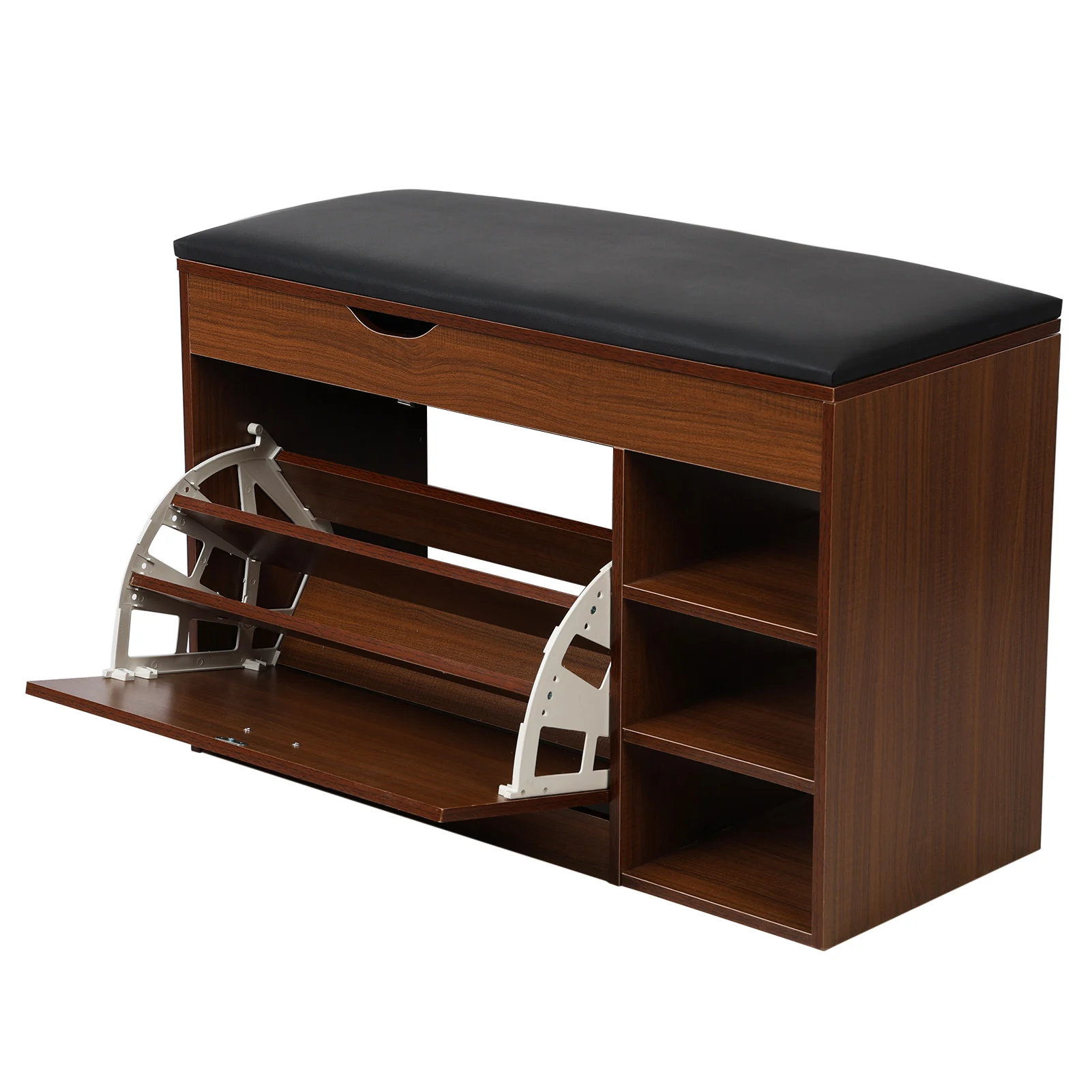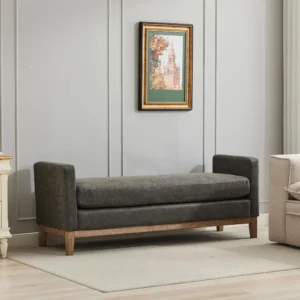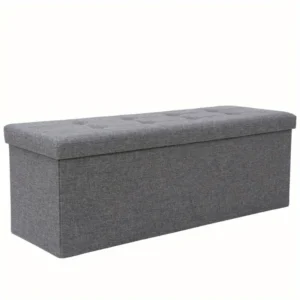Transforming Your Narrow Hallway
Narrow hallways present unique challenges for homeowners. These transitional spaces often become cluttered dumping grounds rather than functional, welcoming areas. Limited width makes organization difficult, while the lack of defined drop zones leads to scattered shoes, keys, and mail. Without proper furniture, these spaces can feel like afterthoughts rather than intentional parts of your home.
A well-chosen bench can transform these problematic spaces into both practical and beautiful areas of your home. Even in hallways measuring just 30-48 inches wide (76-122 cm), a thoughtfully selected bench can provide:
- A dedicated place to sit while putting on or removing shoes
- A designated landing spot for everyday items
- Visual interest in an otherwise overlooked space
- A sense of deliberate design rather than neglected passage
Finding the perfect bench for your narrow hallway isn’t just about buying any piece of furniture that fits—it’s about selecting a solution that maximizes your available space while enhancing your home’s aesthetic. Benches for narrow hallways come in various styles, materials, and configurations specifically designed to work in constrained spaces.
This comprehensive guide will walk you through everything you need to know about selecting the ideal bench for your narrow hallway—from accurate space measurement and bench styles to material selection and styling tips. We’ll help you create a functional entryway that addresses common space-saving entryway ideas while maintaining style and flow in your home.
The Multifunctional Benefits of Hallway Benches
A strategically placed bench transforms a narrow hallway from a simple passageway into a multifunctional space that enhances your daily routines. Unlike purely decorative pieces, entryway benches serve multiple essential purposes that directly address the challenges of limited hallway space.
Practical Functionality
Even the narrowest hallway bench provides significant practical benefits:
- Convenient seating for putting on and removing shoes, especially important for older adults or anyone with mobility challenges
- Dedicated landing zone for everyday items like bags, packages, and mail
- Physical boundary that helps prevent clutter from spreading throughout your home
- Visual anchor that transforms a transitional space into a defined area with purpose
The utility of a hallway bench extends beyond simple convenience. These pieces create natural organization systems where daily activities become more streamlined. Instead of searching for keys or struggling to put on shoes while standing, you have a dedicated space for these routine tasks.
Storage Solutions in Minimal Space
Perhaps the most valuable aspect of hallway benches is their storage capability. In narrow spaces where every inch matters, a bench with built-in storage maximizes functionality without expanding footprint. These organization solutions for hallway spaces include:
- Under-bench shelving for shoe storage
- Lift-top compartments for seasonal items like gloves and scarves
- Drawers for items you want concealed but accessible
- Basket storage for quick organization of small items
A well-designed bench essentially creates storage where none existed before, allowing you to reclaim your hallway from clutter without sacrificing precious floor space.
Aesthetic Transformation
Beyond practical benefits, hallway benches dramatically enhance your home’s aesthetic appeal. They transform utilitarian passages into intentionally designed spaces that make positive first impressions. A narrow hallway bench:
- Creates visual interest in an otherwise plain corridor
- Establishes a design foundation that can be built upon with accessories
- Adds texture, color, and personality to a transitional space
- Makes your entryway feel welcoming rather than merely functional
The psychological benefits shouldn’t be overlooked either. An organized, intentionally designed entryway reduces the stress of coming home to clutter and creates a sense of order that can influence your entire home experience.
Critical Space Assessments Before Your Purchase
The foundation of successful narrow hallway furniture selection begins with accurate measurement. Even the most beautiful bench will become an obstacle if it doesn’t fit your space properly. Before you start shopping, you need precise measurements and a clear understanding of your space constraints.
Essential Measurements for Narrow Hallway Benches
For hallways under 48 inches (122 cm) wide, dimensions become critical considerations:
- Maximum bench depth: For hallways under 4 feet wide, look for benches between 10-15 inches (25-38 cm) deep to maintain proper walkway clearance
- Ideal bench width: Determined by your available wall space, but typically between 24-48 inches (61-122 cm) for narrow hallways
- Recommended bench height: Standard seating height of 17-19 inches (43-48 cm) for comfortable use
- Minimum walkway clearance: Maintain at least 30-36 inches (76-91 cm) of passage space for comfortable movement
Understanding ideal bench dimensions ensures your new furniture enhances rather than obstructs your space. Remember that proper scale is just as important as ensuring the bench physically fits.
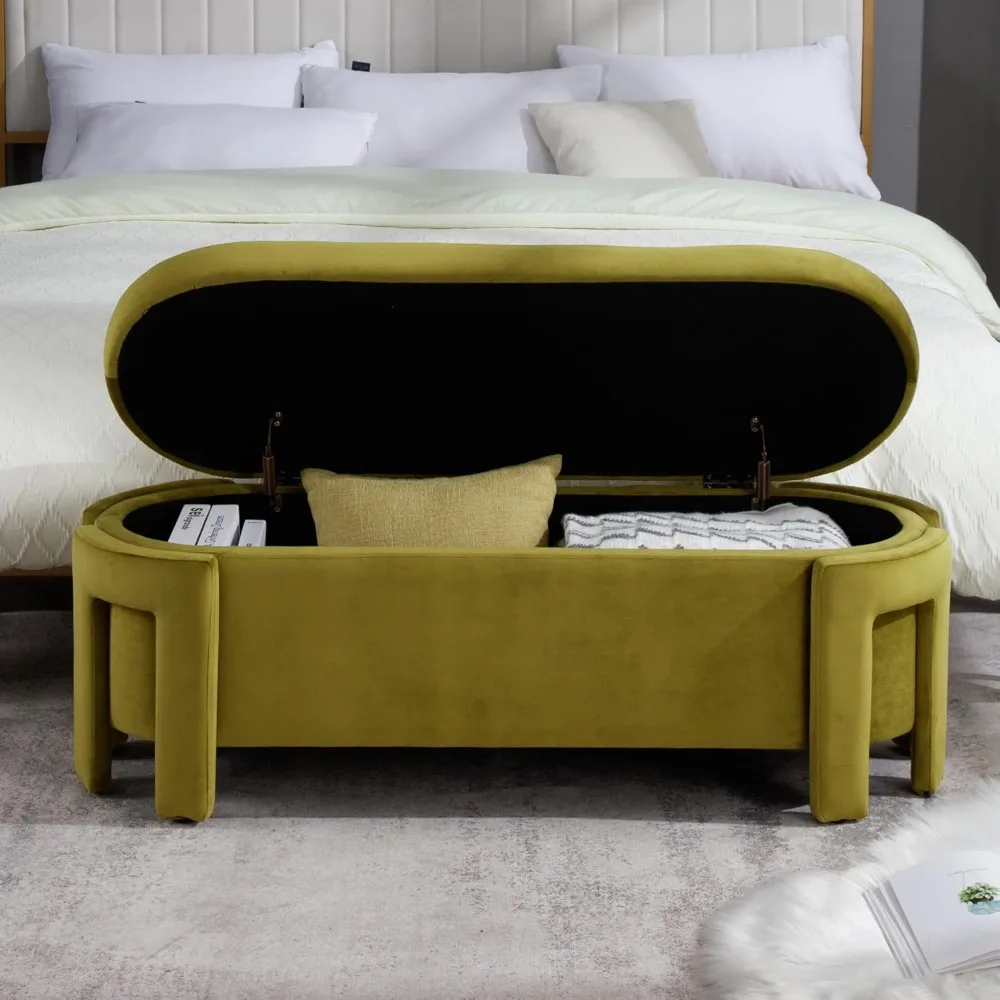
Measurement Checklist for Success
Follow this step-by-step process to determine exactly what size bench will work in your space:
- Measure hallway width at multiple points (hallways aren’t always uniform)
- Measure available wall length where the bench will be placed
- Account for door swing paths to avoid blocking entry/exit
- Note any existing fixtures like radiators, vents, or electrical outlets
- Calculate minimum walkway clearance needed based on household traffic
- Determine ideal bench depth by subtracting walkway clearance from total width
This comprehensive approach to choosing a compact bench prevents costly mistakes and ensures your bench enhances rather than hinders movement through your space.
Functional Priority Assessment
Beyond physical fit, consider which functions are most important for your specific needs:
- Is seating your primary concern, or do you need substantial storage?
- Will the bench serve mainly as a drop zone for mail and keys?
- Do you need space for multiple people to sit simultaneously?
- Will the bench need to accommodate shoes or seasonal accessories?
These functional priorities will guide your decisions about bench type, size, and features. A bench that perfectly fits your space physically but doesn’t address your functional needs will ultimately disappoint.
Visual Proportion Considerations
The visual weight of your bench is just as important as its physical dimensions in a narrow space. Consider:
- Visual lightness (pieces with open bases, raised legs, or transparent elements)
- Color impact (lighter colors tend to feel less imposing in narrow spaces)
- Material density (some materials naturally appear heavier than others)
- Height profile (lower profiles generally feel less imposing in tight spaces)
A physically small bench with heavy visual weight can make a narrow hallway feel cramped, while a visually light design maintains an open feel even with larger dimensions.
Shallow-Depth Bench Types Designed for Narrow Spaces
Narrow hallways require specialized bench designs that maximize functionality while minimizing footprint. Understanding the different space-saving entry benches available helps you select the perfect solution for your specific constraints.
Slim Backless Benches: Minimalist Space-Savers
Backless benches represent the most space-efficient option for extremely narrow hallways:
Pros:
* Minimal depth (often just 10-12 inches/25-30 cm)
* Clean visual profile that doesn’t overwhelm narrow spaces
* Versatile placement options (can be tucked under console tables)
* Often lightweight and easy to move when needed
Cons:
* Limited comfort for extended sitting
* No back support for those who need it
* May offer less storage than other options
These streamlined designs work particularly well in hallways under 36 inches (91 cm) wide where every inch of clearance matters. Their simple profiles complement various design styles without creating visual clutter.
Shoe Storage Benches: Organization Specialists
For entryways plagued by shoe clutter, dedicated shoe storage benches offer targeted solutions:
Pros:
* Dedicated compartments or shelves for footwear organization
* Prevents shoes from cluttering walkways
* Available in surprisingly narrow profiles (12-15 inches/30-38 cm deep)
* Immediately reduces visual clutter in the hallway
Cons:
* Specialized design limits versatility
* May have less comfortable seating surfaces
* Often requires regular maintenance to stay organized
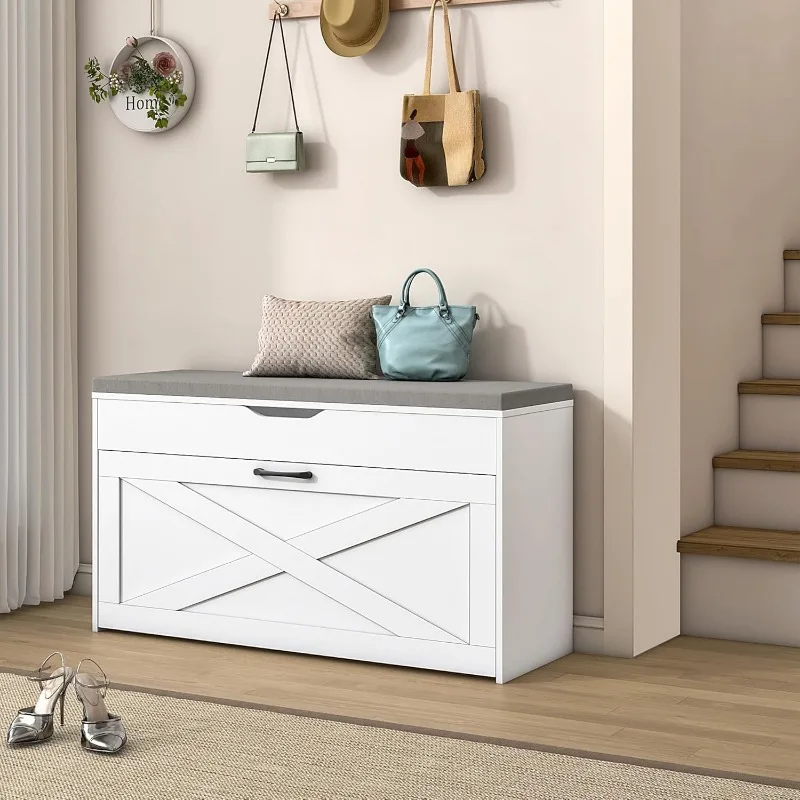
These specialized benches can accommodate 4-8 pairs of shoes typically, making them ideal for smaller households or as supplementary storage for frequently worn footwear.
Storage Benches: Hidden Organization
Storage benches with built-in compartments maximize the utility of narrow spaces:
Pros:
* Concealed storage for items you don’t want visible
* Various storage configurations (flip-top, drawers, baskets)
* Eliminates need for additional storage furniture
* Maintains clean visual lines when closed
Cons:
* May require additional clearance for accessing storage compartments
* Typically deeper than simple seating benches
* Moving parts can wear with heavy use
Storage capacity varies significantly between models. Flip-top versions generally offer the most storage volume but require clearance space to open, while drawer systems allow access without moving the bench away from the wall.
Wall-Mounted and Floating Benches: Floor Space Maximizers
For extremely tight spaces, wall-mounted options create seating without consuming floor area:
Pros:
* Maximizes floor clearance for easy cleaning
* Creates seating with minimal footprint
* Often appears visually lighter than floor-standing options
* Can be installed at custom heights
Cons:
* Installation requires wall anchoring and possible professional help
* Weight capacity typically lower than floor-standing models
* Limited storage options compared to traditional benches
These innovative solutions work particularly well in hallways where floor space is at an absolute premium or where creating a sense of openness is a priority.
Narrow Upholstered Benches: Comfort in Compact Spaces
Adding softness and texture to narrow hallways becomes possible with slim upholstered designs:
Pros:
* Adds comfort and warmth to hard-surfaced hallways
* Provides sound-dampening properties in echo-prone areas
* Available in various fabrics to complement any design aesthetic
* Often visually lighter than solid wood or metal alternatives
Cons:
* Upholstery requires more maintenance in high-traffic areas
* May collect dust and debris more readily
* Often sacrifices storage capabilities for comfort
These comfortable options typically range from 12-16 inches (30-40 cm) in depth, making them suitable for hallways at least 42 inches (107 cm) wide.
Material Selection for Durability and Style Compatibility
The materials you choose for your narrow hallway bench significantly impact both its functionality and aesthetic contribution to your space. Each material brings distinct benefits and considerations, particularly in the context of limited space.
Wood Options for Timeless Appeal
Wooden benches remain the most popular choice for hallways, offering excellent durability and design versatility:
- Solid hardwoods (oak, maple, walnut) provide exceptional durability but tend to be heavier and more substantial
- Pine and other softwoods offer lighter weight and lower cost but may show wear more quickly
- Engineered woods and veneers provide cost-effective solutions with the appearance of premium woods
- Reclaimed and distressed woods add character and work particularly well in farmhouse and rustic designs
Wood bench maintenance requirements vary by finish. Sealed woods offer the most practical option for high-traffic hallways, requiring only occasional dusting and cleaning with appropriate wood products.
Metal Frameworks for Visual Lightness
Metal-framed benches create visual space in narrow hallways:
- Steel frames (often powder-coated) provide exceptional strength with minimal visual bulk
- Iron elements add architectural interest and traditional character
- Aluminum components reduce weight while maintaining structural integrity
- Mixed metal finishes (brass, bronze, copper accents) add warmth and design detail
Metal frameworks paired with wood or upholstered seats create hybrid designs that balance durability with comfort while maintaining a light visual footprint ideal for narrow spaces.
Upholstery Considerations for Comfort
When selecting upholstered elements for narrow hallway benches, performance matters:
- Performance fabrics with stain resistance work best in high-traffic areas
- Leather and faux leather options offer easy cleaning and durability
- Removable cushions provide cleaning flexibility and replacement options
- Textural fabrics add visual and tactile interest to minimalist designs
For hallways exposed to outdoor elements, moisture-resistant fabrics become especially important to prevent mildew and staining.
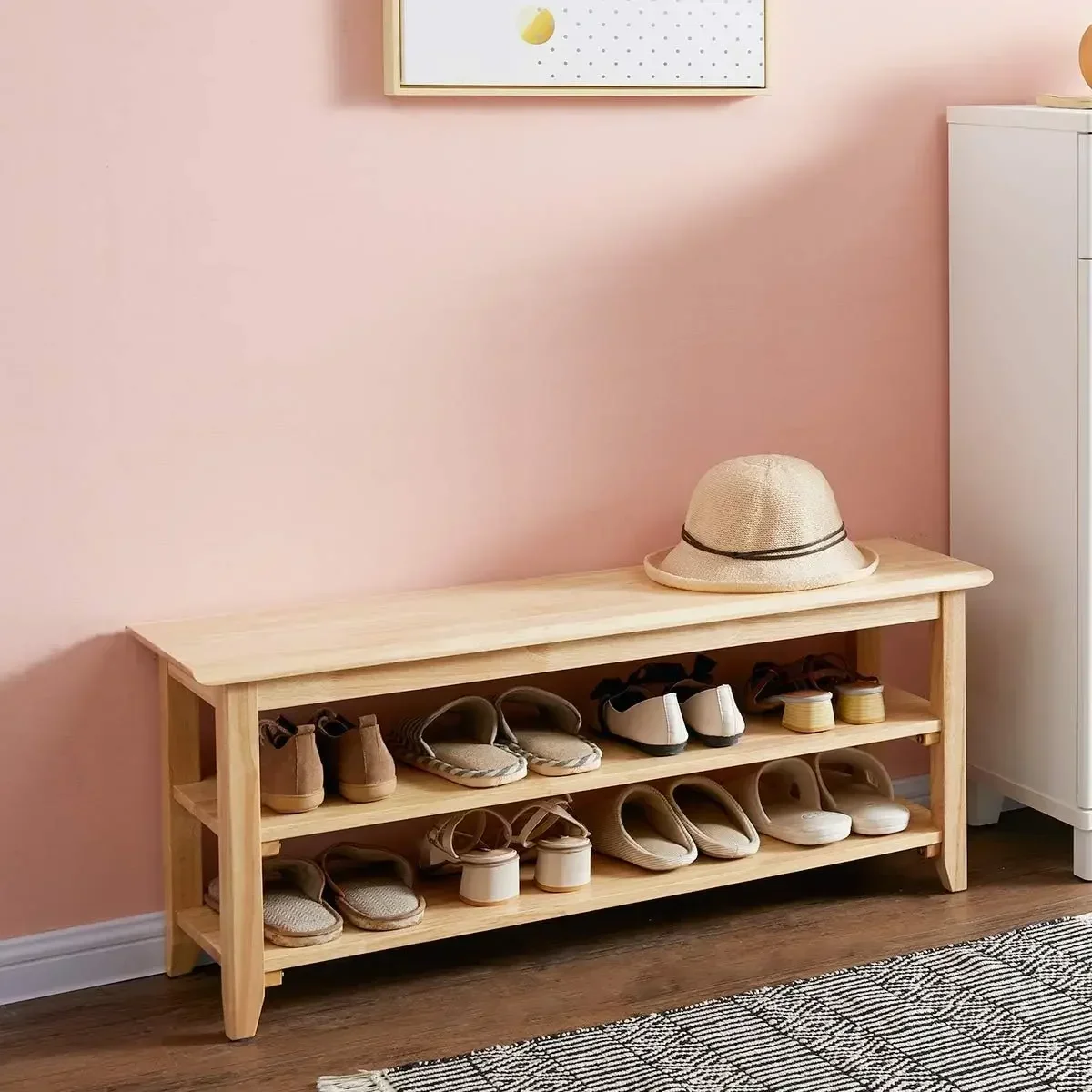
Natural Materials for Lightweight Appeal
Lightweight natural materials offer both visual interest and practical benefits:
- Rattan and wicker create airy, textural pieces perfect for coastal and bohemian styles
- Bamboo provides surprising strength with environmental benefits
- Seagrass and rush seating adds natural texture to wooden frames
- Cork elements offer unique texture and sustainable benefits
These materials work particularly well in modern bench designs where maintaining visual lightness is essential to preventing a cramped feeling.
Material Matching for Design Cohesion
When selecting materials, consider how they’ll integrate with your existing hallway elements:
- Match wood tones to existing trim or flooring for cohesive design
- Echo metal finishes found in lighting fixtures or door hardware
- Complement wall colors with upholstery that either contrasts or coordinates
- Consider existing textures (smooth walls, textured wallpaper, patterned flooring) when adding new textural elements
The right material choices create harmony rather than competition between your bench and surrounding hallway features.
Styling Your Bench: Creating a Cohesive Entryway Vignette
A bench alone transforms a narrow hallway, but thoughtful styling creates a complete design statement. Creating a cohesive entryway around your bench elevates the entire space from merely functional to genuinely welcoming.
Wall Decor Pairing Strategies
The wall space above your bench presents prime styling opportunities:
- Mirrors expand visual space and provide a last-look spot before leaving home
- Wall hooks or pegs at 48-60 inches (122-152 cm) height add functional storage without consuming floor space
- Artwork establishes color schemes and adds personality at eye level
- Narrow shelving (6-8 inches/15-20 cm deep) provides display space without protruding too far
For extremely narrow hallways, consider vertical arrangements that draw the eye upward rather than outward. This creates a sense of height that compensates for limited width.
Accessorizing with Purpose
Select accessories that enhance both function and beauty:
- Slim baskets contain small items while adding texture
- Decorative trays create boundaries for keys and everyday essentials
- Slender table lamps (when outlets are available) add warm lighting
- Compact plants bring life to the space without consuming valuable room
The key to successful narrow hallway accessorizing is selectivity—choose fewer, more meaningful pieces rather than numerous small items that create visual clutter.
Lighting Integration
Strategic lighting transforms how your entryway bench area feels:
- Sconces mounted at approximately 5.5-6 feet (168-183 cm) provide ambient lighting without taking up surface space
- Picture lights illuminate art while providing subtle ambient light
- Small accent lamps (under 8 inches/20 cm diameter base) add warmth to bench surfaces
- Recessed lighting creates general illumination without visual intrusion
Proper lighting not only enhances the appearance of your bench area but also improves the functionality of this transitional space.
Color Strategy for Narrow Spaces
Color choices significantly impact how spacious your hallway feels:
- Light, neutral bench colors create an airy, open feeling
- Color coordination between bench, walls, and accessories creates visual flow
- Strategic pops of color draw the eye to intentional focal points
- Monochromatic schemes in varying textures create depth without visual heaviness
For extremely narrow hallways, consider space-saving seating solutions in colors that blend with wall tones to minimize visual disruption of the space.
Creating Visual Flow
Your bench styling should guide movement through the hallway rather than impeding it:
- Maintain clear sightlines through the space
- Avoid top-heavy arrangements that create a sense of imbalance
- Ensure accessories don’t protrude into walkway areas
- Create rhythm with repeating elements (colors, shapes, textures) that lead the eye forward
The most successful modern bench styling approaches create harmony between functional requirements and aesthetic desires without compromising either.
Smart Features to Prioritize: A Buyer’s Guide
When investing in a narrow hallway bench, certain features significantly enhance functionality and longevity. This checklist helps you identify the most important elements to prioritize during your selection process.

Essential Dimension Verification
Before purchase, confirm these critical measurements:
- Bench depth is appropriate for your hallway width (ideally 12-15 inches/30-38 cm for very narrow spaces)
- Overall height allows comfortable seating (17-19 inches/43-48 cm from floor to seat)
- Total width fits your available wall space with at least 2 inches (5 cm) clearance on each end
- Interior storage dimensions (if applicable) accommodate intended contents
- Weight capacity meets your household needs (typically 250-400 lbs/113-181 kg)
Always measure twice before ordering, and remember that manufacturer specifications sometimes include protruding elements not apparent in photos.
Storage Functionality Assessment
For benches with storage capabilities, evaluate:
- Access mechanism (lift-top, drawers, open shelving) and how it functions in your specific space
- Interior compartmentalization options for organizing different items
- Closure quality including hinges, drawer slides, and lid supports
- Weight capacity of storage components separate from seating capacity
- Ease of cleaning interior storage spaces
The most practical storage solutions for narrow hallways typically feature either open shelving that doesn’t require additional clearance for access or drawers that can be opened without moving the entire bench.
Construction Quality Indicators
Identify these markers of quality construction:
- Joinery methods (dovetail, mortise and tenon connections superior to just screws or staples)
- Material thickness of main structural components (thicker generally indicates better quality)
- Finish consistency even in less visible areas
- Hardware quality including metal gauge and finish consistency
- Stability when tested (no wobbling or shifting during normal use)
Quality construction becomes especially important in narrow hallways where furniture receives daily interaction and potential bumps from passing traffic.
Safety Considerations
For high-traffic hallway areas, prioritize:
- Rounded corners to prevent injury in tight passages
- Sturdy construction with appropriate weight capacity
- Stable design that doesn’t tip easily if leaned against
- Child-safety features if applicable (soft-close lids, rounded edges)
- Secure wall mounting options for floating or top-heavy designs
Many of the best small benches for entryways incorporate these safety features without sacrificing style or functionality.
Practicality Features Worth Paying For
Certain premium features justify additional investment:
- Water-resistant finishes for homes with children or pets
- Stain-resistant upholstery for high-traffic areas
- Adjustable leveling feet for uneven floors
- Soft-close mechanisms for hinged storage compartments
- Modular designs that can be reconfigured if needs change
These quality-of-life improvements significantly enhance the daily experience of using your bench and often prevent premature replacement due to wear or damage.
Maintaining Organization and Flow
Even the perfect bench can become an obstacle if not properly maintained. Establishing systems that preserve both functionality and aesthetics ensures your narrow hallway remains an asset rather than a frustration.
Establishing Daily Organization Routines
Create simple habits that prevent clutter accumulation:
- Implement a “one-in, one-out” policy for items stored in bench compartments
- Designate specific zones for different family members’ belongings
- Schedule weekly quick-cleanouts to prevent overflow
- Create simple systems that everyone in the household can follow
- Use smaller containers within larger storage compartments for easier organization
These organizational systems work with various affordable entryway bench solutions to maximize their effectiveness regardless of price point.
Maintaining Clear Pathways
Protect your hallway’s primary function as a passage:
- Establish boundary rules for items that can extend into walkways
- Consider floor markers (decorative rugs) that visually define walking zones
- Regularly assess if bench accessories are encroaching on passage space
- Be mindful of seasonal adjustments (winter coats require more clearance)
- Remove items that consistently create obstacles
Remember that in narrow hallways, maintaining clear walkways isn’t just about convenience—it’s also about safety and accessibility for all household members.
Seasonal Rotation Strategies
Adapt your bench organization to changing needs throughout the year:
- Swap winter accessories for summer items as seasons change
- Rotate holiday-specific decor to keep the space fresh
- Adjust lighting as natural light changes with seasons
- Consider slipcovers or cushion changes to refresh the space seasonally
- Maintain a small “overflow” storage area elsewhere for seasonal transitions
These rotation strategies keep your narrow hallway functioning optimally year-round while preventing storage overload during transitional periods.
Frequently Asked Questions About Narrow Hallway Benches
What’s the minimum depth bench that’s still functional for seating?
For adult seating, benches should be at least 10-12 inches (25-30 cm) deep. While shallower options exist, they typically prove uncomfortable for actual sitting. Look for benches with slightly angled seats or subtle contouring that maximize comfort even with minimal depth. Remember that deeper benches (14-16 inches/36-40 cm) provide more comfortable seating but require wider hallways to maintain proper clearance.
How can I prevent a bench from making my narrow hallway feel cramped?
Several visual techniques can maintain spaciousness:
- Choose benches with open bases or visible legs rather than solid bases
- Select lighter colors that blend with wall tones
- Look for designs with lower height profiles
- Consider wall-mounted options that preserve floor visibility
- Add a mirror above the bench to expand perceived space
Maximizing small spaces with smart entryway benches involves both physical dimension considerations and visual weight management.

Are backless benches or benches with backs better for narrow hallways?
Backless benches typically work better in very narrow hallways for several reasons:
- They require less depth (often 12-15 inches/30-38 cm vs. 18-24 inches/46-61 cm for backed versions)
- They create less visual obstruction in tight passages
- They allow for flexible seating (can be accessed from either side)
- They often appear lighter and less imposing in restricted spaces
However, benches with backs provide better seating comfort for longer periods and may be worth the additional space if your hallway width allows.
How do I maximize storage in an extremely narrow bench?
To optimize storage in minimal depth:
- Look for compartmentalized designs that create organization within limited space
- Consider vertical storage integration (hooks above the bench)
- Select benches with multiple storage types (open shelf plus hidden compartment)
- Use aftermarket organizers inside bench compartments
- Choose designs where every structural element doubles as storage
Many small entryway bench options incorporate innovative storage solutions specifically designed for tight spaces.
What materials hold up best to heavy hallway traffic?
For high-traffic hallways, these materials offer superior durability:
- Hardwoods with protective polyurethane finishes
- Powder-coated metals that resist scratching and chipping
- Performance fabrics designed for commercial use (look for high rub counts)
- Leather and quality faux leather that can be wiped clean
- Laminates and melamine finishes on engineered woods
The intersection between durability and style is especially important in hallway furniture that faces daily use while also serving as a design focal point.
Entryway Bench with Cushion, Mudroom Bench with Cushion, Shoe Bench for Entryway
$1,186.63 Select options This product has multiple variants. The options may be chosen on the product pageCoat Rack Shoe Bench, Corner Entryway Bench, Corner Hall Tree, Shoe Bench for Entryway
$313.58 Select options This product has multiple variants. The options may be chosen on the product pageEntryway Bench with Back, Modern Entryway Bench, Shoe Bench for Entryway
Price range: $463.13 through $474.44 Select options This product has multiple variants. The options may be chosen on the product pageShoe Storage Bench for Entryway
$459.02 Select options This product has multiple variants. The options may be chosen on the product pageEntryway Bench with Shelf Storage, Shoe Bench for Entryway, Shoe Storage Bench
$194.08 Select options This product has multiple variants. The options may be chosen on the product pageCorner Entryway Bench, Entryway Bench with Cushion, Modern Entryway Bench, Shoe Bench for Entryway
$476.34 Select options This product has multiple variants. The options may be chosen on the product page
How do I coordinate bench style with existing hallway elements?
To create cohesion:
- Identify the dominant architectural style of your home (modern, traditional, transitional, etc.)
- Match wood tones to existing trim, flooring, or nearby furniture
- Echo existing metal finishes (door hardware, light fixtures)
- Select upholstery that complements wall colors and existing textiles
- Consider scale relationship to other hallway elements (lighting, mirrors, art)
Successful integration focuses on creating conversation between elements rather than exact matching.
Transforming Your Narrow Hallway: Final Recommendations
A thoughtfully selected bench transforms narrow hallways from problematic passages into functional, beautiful transitional spaces. The key to success lies in balancing proper measurements with aesthetic considerations and practical features.
Begin your selection process by accurately measuring your space, paying particular attention to minimum walkway clearance requirements. Remember that benches for very narrow hallways typically perform best with depths between 10-15 inches (25-38 cm) to maintain comfortable passage.
Focus on multifunctional designs that serve your household’s specific needs—whether that’s shoe storage, hidden compartments for seasonal items, or simply a comfortable place to sit. The best narrow hallway solutions solve multiple problems without creating new ones.
Consider visual weight alongside physical dimensions. Open-based designs, lighter colors, and visually lightweight materials create spaciousness even in constrained areas. These space-saving corner bench solutions maximize utility while maintaining flow.
Thoughtful styling completes your hallway transformation. Selective accessorizing, appropriate lighting, and complementary wall decor create a cohesive entryway that welcomes visitors and serves daily family needs. Remember that in narrow spaces, editing is just as important as adding—sometimes fewer, more impactful pieces create the most successful designs.
With proper selection and styling, your narrow hallway can become more than just a passage between rooms—it can become a functional, beautiful space that enhances your daily routine and welcomes you home.
Premium Narrow Hallway Bench Solutions by Nested Goods
At Nested Goods, we specialize in solving the unique challenges of narrow hallway spaces with thoughtfully designed bench solutions that blend form and function. Our premium collections address the specific constraints of limited-width areas without compromising on style, comfort, or utility.
Our Slim Profile Collection features benches specifically engineered for hallways under 48 inches wide, with depths ranging from 10-14 inches to maximize walkway clearance. These pieces maintain comfortable seating while creating minimal footprint impact in constrained spaces.
For those prioritizing organization alongside seating, our entryway benches with shelf storage combine comfortable seating surfaces with intelligently designed storage solutions. These multi-functional pieces feature combinations of open shelving, hidden compartments, and specialized storage for everyday items.
Each Nested Goods bench is crafted using premium materials selected for both beauty and longevity in high-traffic areas. From solid hardwoods with protective finishes to performance fabrics designed for everyday use, our material selections ensure these pieces remain beautiful despite daily interaction.
Our design philosophy centers on creating pieces that solve real household challenges without sacrificing aesthetic appeal. The result is a collection of narrow hallway benches that transform problematic spaces into functional, beautiful areas that welcome you home every day.

